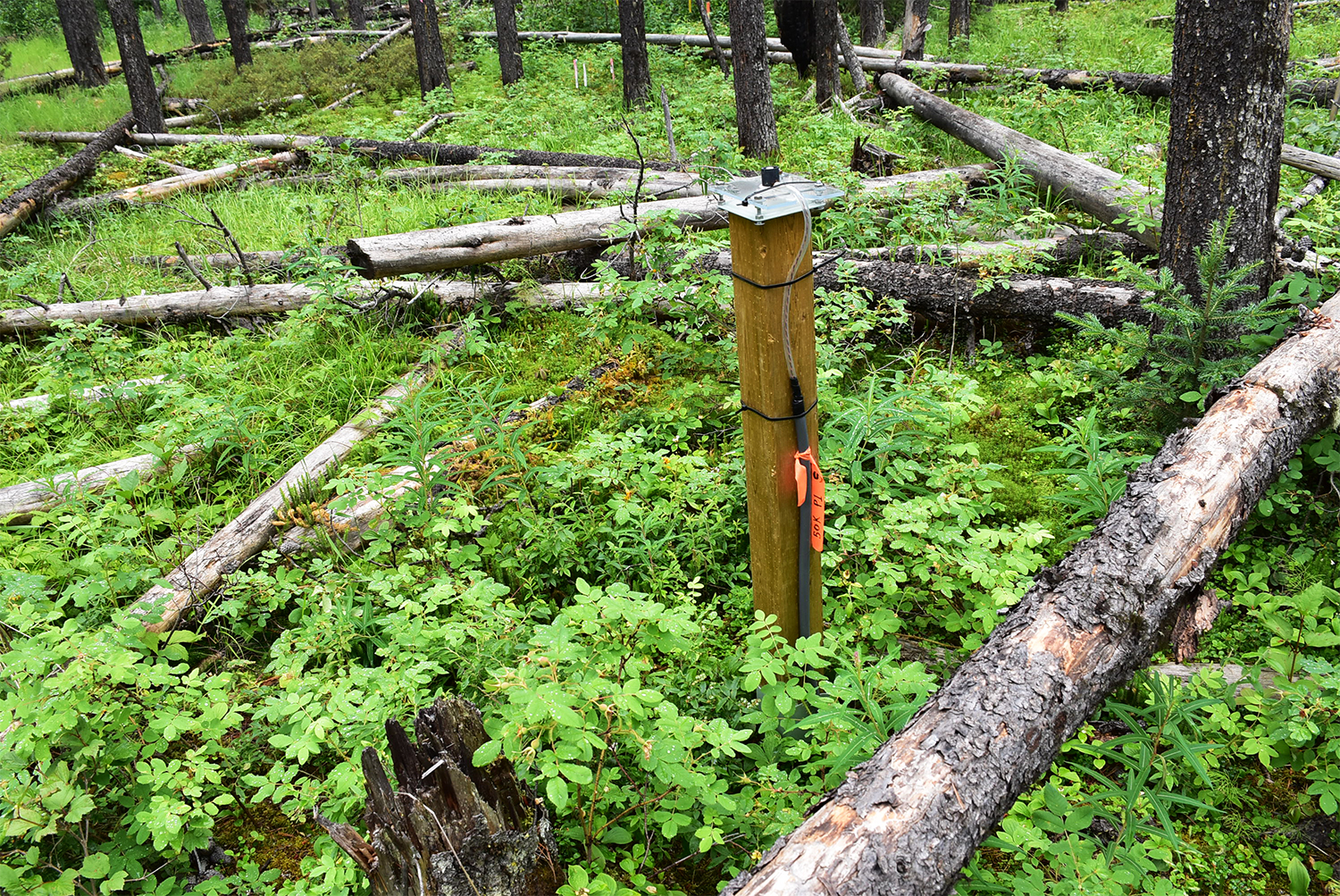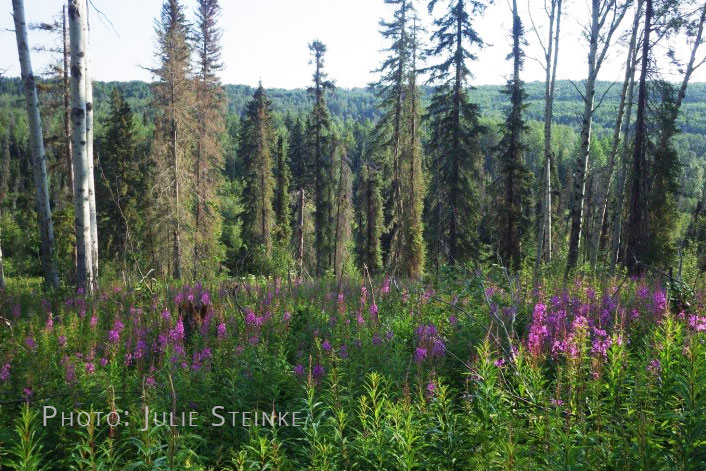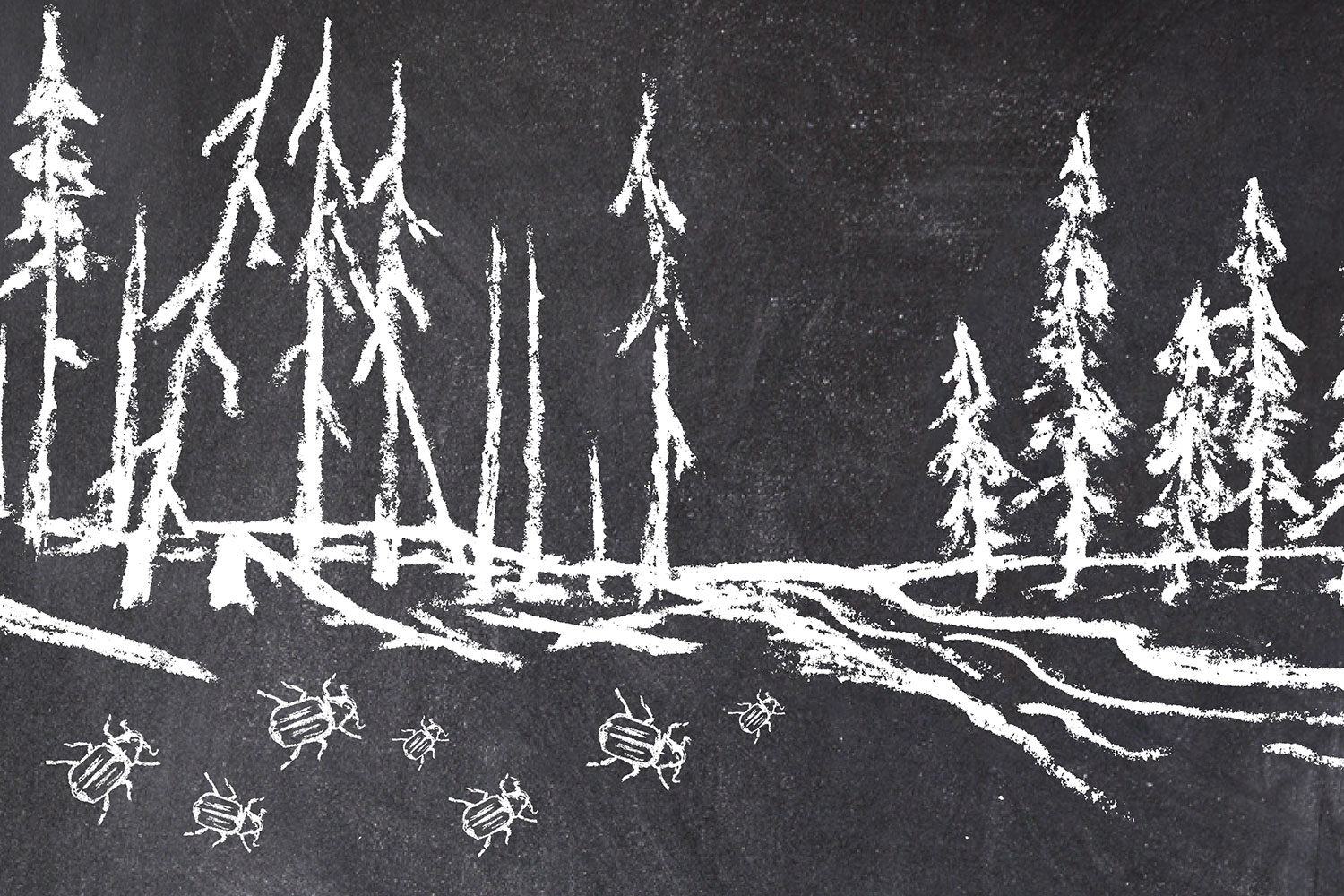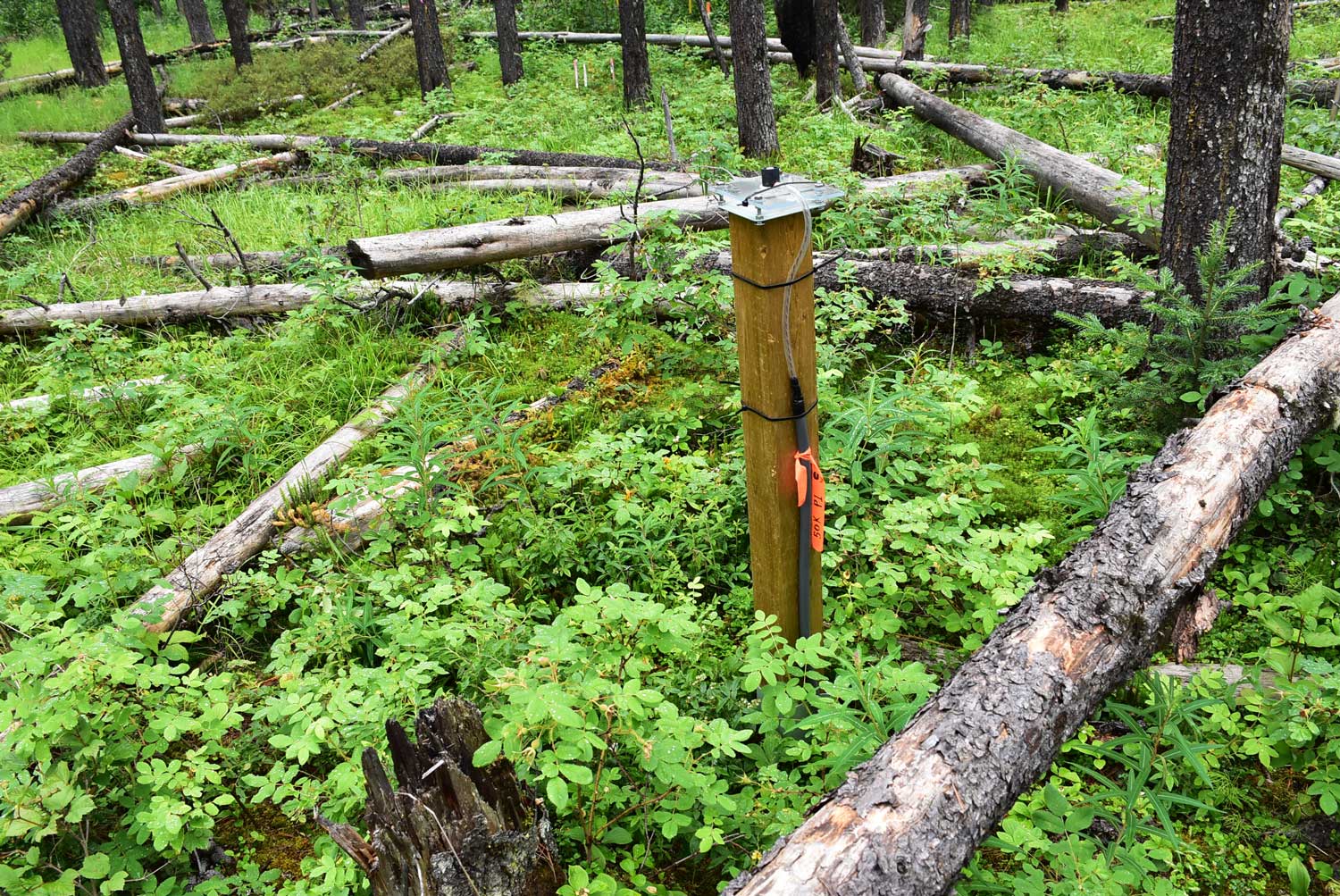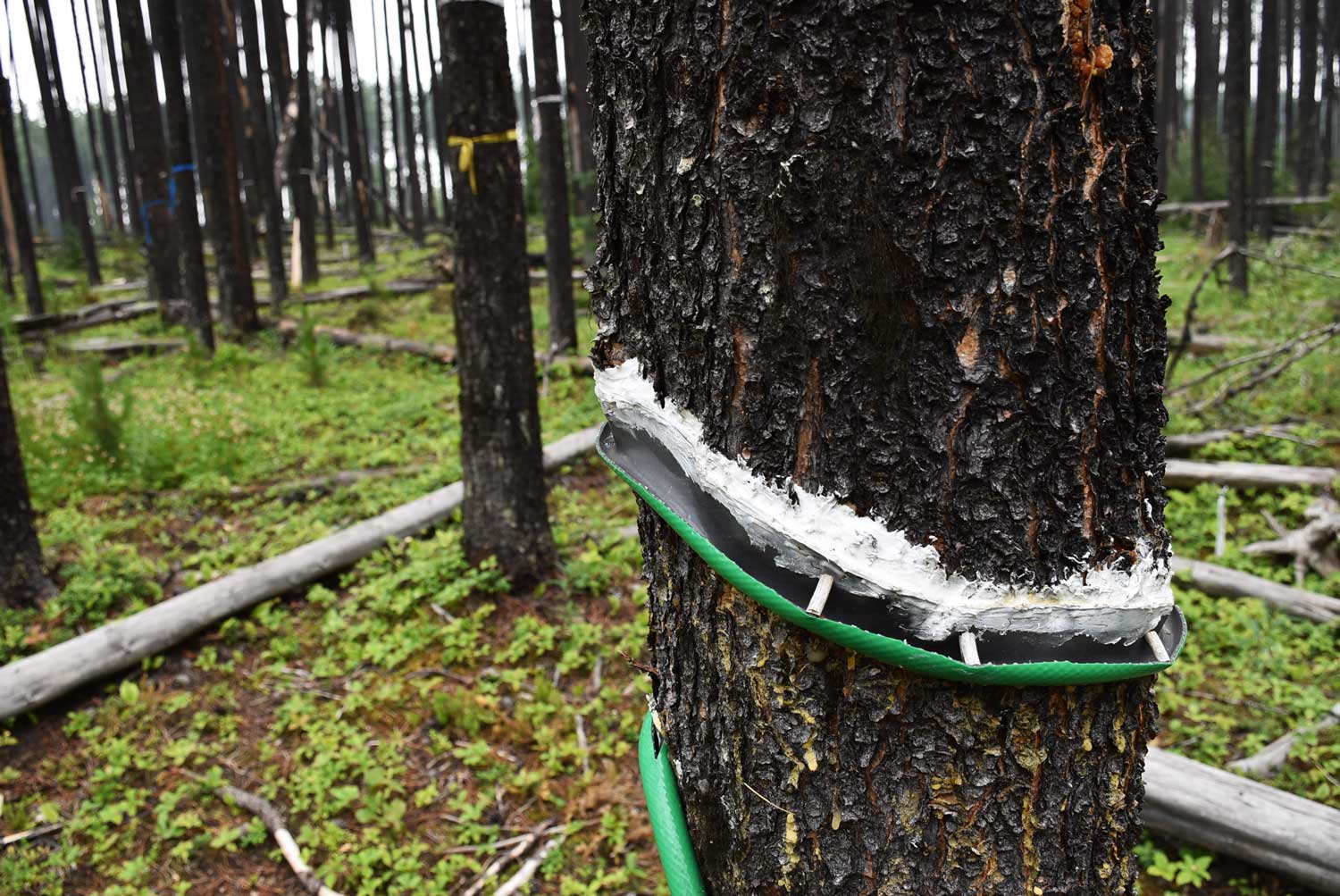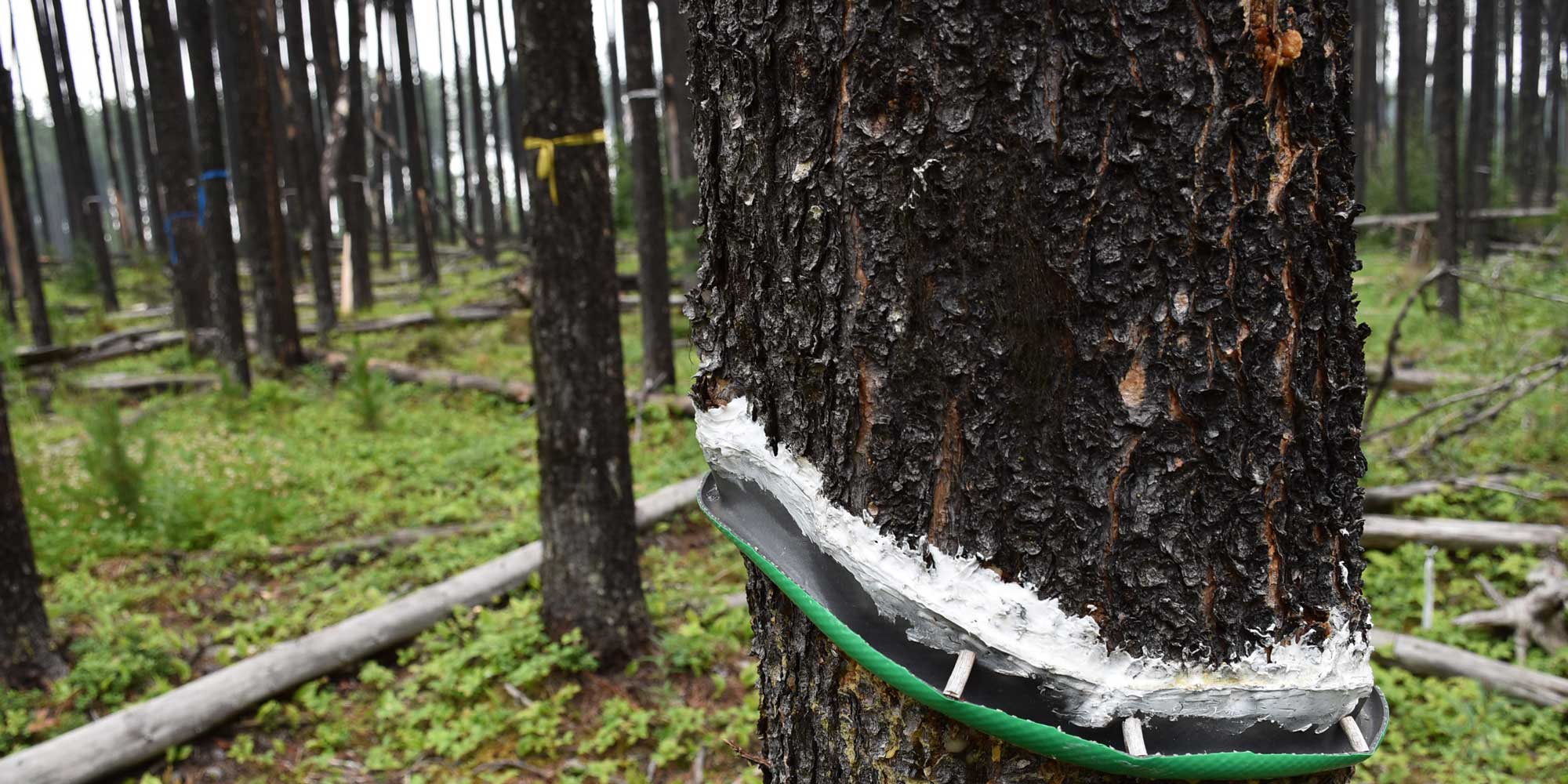
Impacts of Mountain Pine Beetle Attack on Hydrology and Post-attack Vegetation and Hydrology Recovery in Lodgepole Pine Forests in Alberta (Phase 2 Grey Attack)
Examining hydrological and vegetation responses in the grey attack stage.
This project will examine hydrological and vegetation responses in the grey attack stage. Phase 1, completed in 2012, looked at the impact during the red attack phase. Now, with the treated stands in the grey attack stage, new measurements are being taken to detect changes.
In 2009, Lodgepole pine stands near Robb, Alberta, were treated to simulate mountain pine beetle (MPB) attack. Twelve large replicated stand-scale plots (1.3 to 2.2 hectares) were used to produce two levels of simulated MPB attack (50% & 100%). From 2008–2012, these stands were monitored to compared to hydrologic and vegetation responses in small clear cuts, and untreated control stands. This characterizes the “red attack” phase of MPB.
In 2014, five years after the treatments the stands are to be revisited to understand the hydrologic & vegetation responses of “grey attack” stands. This information is being used to drive hydrological models and inform a decision support tool under development in the government to prioritize stand rehabilitation efforts in regions heavily affected by MPB.
Background
Mortality of canopy trees after Mountain Pine Beetle (MPB) attack can produce significant changes in hydrology and greatly influence vegetation communities and the future successional development of lodgepole pine dominated forests. The responses of lodgepole pine forests along the eastern slopes of the Rocky Mountains in Alberta are difficult to predict because the climate regime, hydrology, and forest composition are quite different from the pine forests in British Columbia in which we have longer-term observations of the impacts of MPB attack. Recovery of ecosystem processes, such as hydrology, along with regeneration of canopy species will be key to future forest productivity and ecological value of landscapes affected by MPB. Lodgepole pine dominated montane forests have historically been exposed to a disturbance regime dominated by fire; hence, they may not be well adapted to recover from the very different type of disturbance caused by MPB attack. In addition, the incremental or compensatory effects on hydrology of management practices such as salvage logging are not currently understood but may be key components that influence management outcomes.
Trees retain dead needles and branches for two to four years post-attack; this maintains snow/rain interception, severely limits wind and radiation penetration to the forest floor, and restricts compensatory forest floor evaporation. Understory vegetation and below ground responses to canopy death directly influence the light, soil moisture and nutrient conditions, and regeneration microsites for trees. It is certain that the environmental / competitive conditions and regeneration microsites available in a MPB-killed forest stand will differ as compared to a disturbance like fire or forest harvesting. The broad goals of this work are to quantify effects of MPB attack and management intervention (salvage logging) on forest stand-level hydrology and vegetation through a controlled field experiment in modal ‘pure’ lodgepole pine sites in west-central Alberta. This experimental approach provides an understanding of hydrologic responses and is generating data needed to scale and model hydrological effects of MPB effects at larger watershed or regional scales. Further, we will document responses of understory vegetation (including advanced tree regeneration, shrubs, herbaceous plants, lichens and mosses) to canopy death and assess the possibilities for natural pine regeneration in post-attack stands. This information will be applied towards an understanding of the role of understory vegetation in hydrologic recovery and will also provide insight into future forest regeneration and growth.
In Phase I of the study we established an experiment in which chemical girdling was used to simulate two levels of MPB attack of mature lodgepole pine forests in west-central Alberta to produce fully controlled experiment. Hydrological, vegetation and below-ground responses were compared between these treatments as well as salvage harvesting and untreated control (four treatments with three replicates, 1–2.2 hectare each) over a four year period (2008–2011).
Briefly, results from the first phase of the study were:
- The chemical girdling results in a gradient of canopy mortality and trees retained their foliage and branches after death, effectively simulating the mortality process post-MPB.
- Interception of precipitation is a major driver of stand-level water balance; interception did not change much in the red attack stage because trees retained their needles; this is expected to change as trees lose their needles and small branches and move into the grey attack stage (Piña 2012).
- Stand-level transpiration declined in the 100% attack stands due to tree death but in the 50% attack stands the remaining live trees were able to compensate such that these stands had transpiration levels similar to or exceeding those of control plots (Piña 2012).
- The reduced transpiration in 100% attack stands was associated with increased soil moisture (Piña 2012).
- A scaling exercise explored impacts of MPB attack across a range of climate and seasonal precipitation conditions and showed the conditions under which an excess of water could be expected for MPB attacked stands (Piña 2012).
- Understory plant communities and below-ground environment and microbial communities showed short-term resistance to canopy tree death due to the simulated MPB treatment; the salvage harvested treatment resulted in much stronger and immediate responses (McIntosh and Macdonald 2013; McIntosh et al. 2013).
- The control and treated stands had poor availability of hospitable microsites for regeneration of lodgepole pine; the most favour ones were exposed mineral soil and decayed wood (McIntosh and Macdonald 2013).
Commencing in 2014 we proposed to launch Phase II of the project during which we will document the longer-term hydrologic and understory vegetation responses that are likely to accompany the loss of foliage as the stand moves from red to grey attack stage. We will determine whether further hydrologic responses accompany the loss of foliage as we move from red to grey attack stage or whether hydrological recovery has begun to take place. We will also determine whether the understory vegetation and below-ground components still exhibit resistance to the effects of simulated MPB attack or whether they have begun to respond to canopy changes at the grey attack stage. Assessment of salvage harvesting outcomes and the potential for natural regeneration of pine in forests receiving the different experimental treatments will also be investigated.
Objectives and Hypotheses
- Examine whether further hydrologic responses accompany the loss of foliage as we move from red to grey attack stage or whether hydrological recovery has begun to take place. We hypothesize that as we move to the grey attack stage canopy interception will decline, evapo-transpiration will decline further and soil moisture will increase further.
- Determine whether the understory vegetation and below-ground components still exhibit resistance to the effects of simulated MPB attack or whether they have begun to respond to canopy changes at the grey attack stage. We hypothesize that as we move to the grey attack stage litterfall and decomposition will increase, leading to increased soil nutrient availability – accompanying the increased soil moisture mentioned above. Further, understory vegetation in patches dominated by herbaceous vegetation will increase in cover and diversity in response to increased light, soil moisture and nutrient availability but heavily moss-dominated patches will show continued resistance.
- Explore the potential for natural regeneration of lodgepole pine in stands post- MPB attack, assess how responses in the understory vegetation may be impacting this, and describe the longer-term implications for successional development. We hypothesize that the increases in herbaceous cover described above will have substantial negative effects on the success of lodgepole pine seedling regeneration but that in moss-dominated patches the feather moss layer will begin to degrade and become more favourable for seedling establishment.
- Update forest water balance models of hydrologic effects of MPB attack to include the grey attack stage and assess the potential range of variation in impacts across several hydroclimatically distinct eastern slopes forested regions in Alberta
Related Publications
McIntosh, A.C.S and S.E. McDonald. 2013 Potential for lodgepole pine regeneration after mountain pine beetle attack in newly invaded Alberta stands. Forest Ecology and Management
Volume 295 p. 11–19
McIntosh, A.C.S, S.E. McDonald and S.A. Quideau. 2013 Linkages between the forest floor microbial community and resource heterogeneity within mature lodgepole pine forests. Soil Biology and Biochemistry 63, p. 61–7
Quicknotes
Effects of simulated Mountain Pine Beetle attack on post-attack vegetation and below-ground dynamics in lodgepole pine forests. July 2010: By: Anne McIntosh, Ellen Macdonald & Uldis Silins
Rainfall interception losses in mature lodgepole pine forests at risk from Mountain Pine Beetle attack. June 2010: By: Pablo Piña-Poujol, Uldis Silins & Ellen MacDonald
Effects of Mountain Pine Beetle Attack on hydrology and post-attack vegetation and hydrologic recovery in lodgepole pine forests. Jan 2009 By: Uldis Silins & Ellen MacDonald
The project kicks off, led by Axel Anderson
Data collection on soil and vegetation regeneration completed












